As a Vagrant, you’ve been riding the rails, going from town to town. But when you got onto this last train, you had know idea that it was haunted. And the spirits that dwell on the train want you to keep them company…for all eternity!
What Is Vagrantsong?
Vagrantsong is a cooperative, story-driven boss-battling game for 1-4 players, ages 14 and up, and takes about 45-120 minutes to play. It retails for $80, and is currently available directly from the Wyrd webstore or through Amazon. While the subject matter of restoring humanity to various ghosts that are trying to harm you can seem frightening on the surface, the old-style cartoon design of the game helps to make the game more family-friendly.
Vagrantsong was designed by Matt Carter, Justin Gibbs, and Kyle Rowan, and published by Wyrd Miniatures, with illustrations by Nguyen Mai Diem.

Vagrantsong Components
This is what comes in the box:
- Train Board
- Rule Book
- Scenario Book
- Bindle Bag
- 6 Bones (dice)
- 7 Vagrant Standees
- 20 Haint Standess
- 10 Haint Bases
- 7 Vagrant Bases
- 6 Vagrant Cards
- 85 Skill Cards
- 32 Junk Cards
- 3 Malady Cards
- 85 Ritual Cards
- 1 Seance Card
- 1 Pup Card
- 6 Westbound Cards
- 4 Quick Reference Cards
- 20 In-Between Cards
- 50 Tokens and Markers
One of the first things that you’ll notice about Vagrantsong is Nguyen Mai Diem’s distinctive art style. It has a look that’s reminiscent of old Betty Boop cartoons, or the more recent Cuphead video game.
The tri-fold board represents the three cars on the train, and has several tracks running along the edges. There are also spaces to attach cards that are used in each scenario.
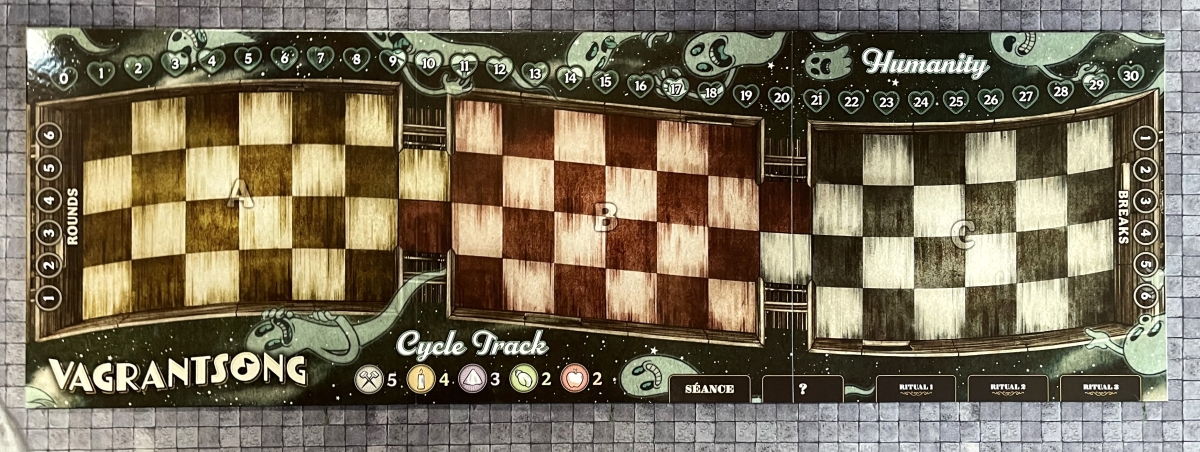
Instead of using plastic miniatures, Vagrantsong uses acrylic standees. Not only does this let the graphic design shine, but it keeps the box to a manageable size on your shelf.
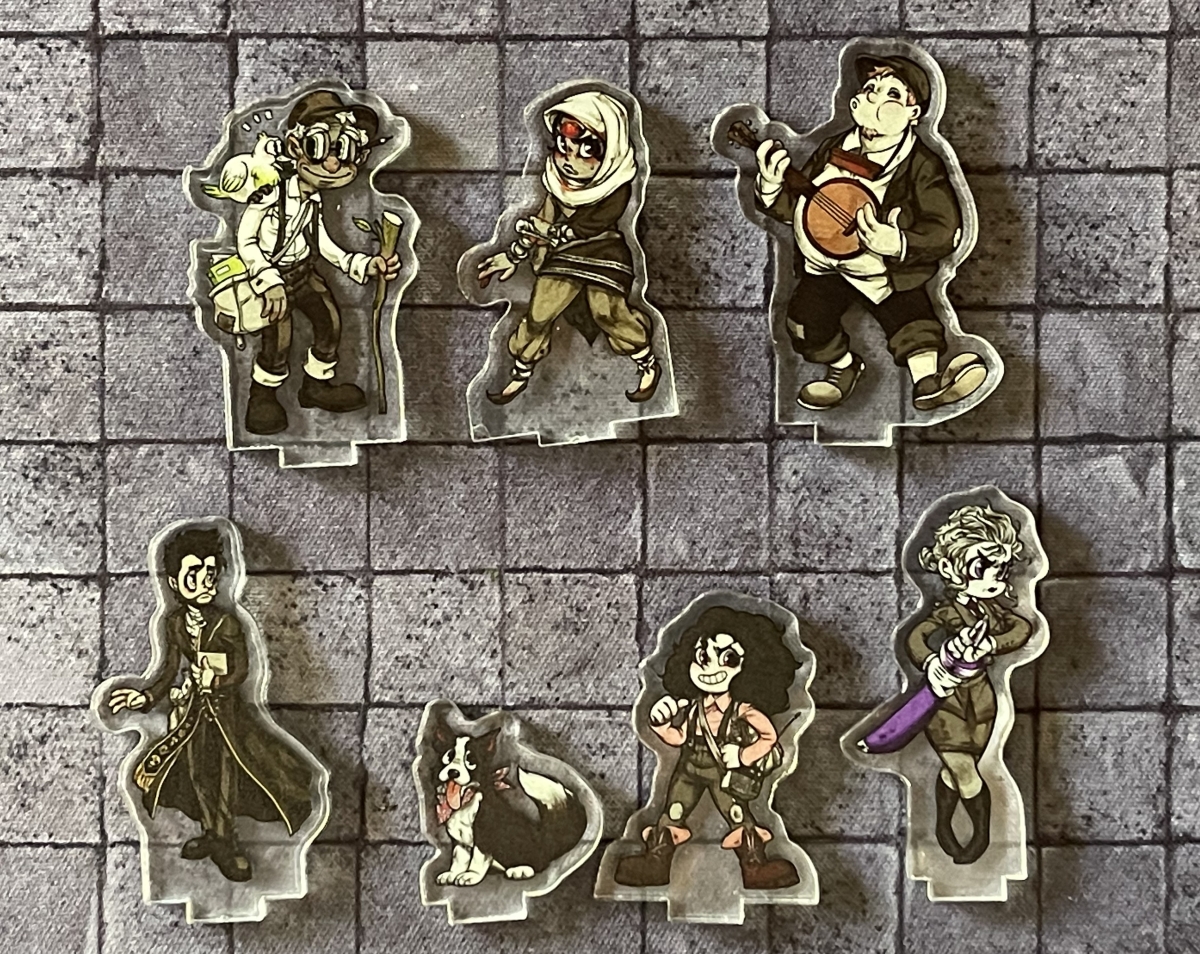
Each of the standees has a protective film over the illustration. You can leave the film on to protect the standees, or peel it off to have a more vibrant image. It does take a bit of work with your fingernails to get an edge worked up on a corner of the standees so you can peel the film off.
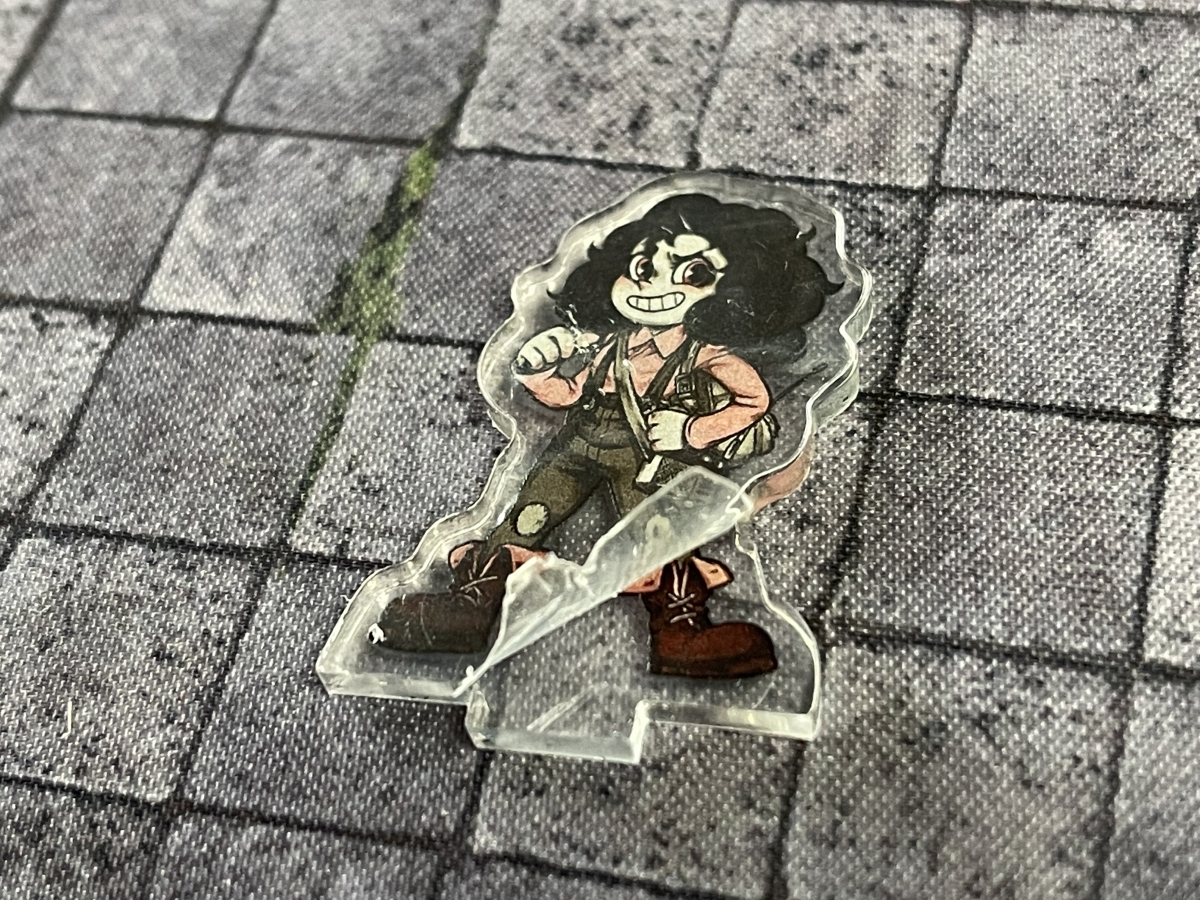
As you can see from above, the illustrations on the standees are much brighter with the film removed. I’d suggest removing them for all of the Vagrants right off the bat, and then do each Haint (the game’s name for ghosts) as they appear in the scenarios.

Each Vagrant is unique, and has a card that shows their special abilities and what base actions they can take, as well as what roll of the bones (aka dice) they will need to make for the action to be successful. There is also a track at the top of the card for their humanity.

There are also slots to add Skill Cards, and a single item of junk (the Wayfarer being the exception, who can hold 2 pieces of junk). Skill cards have diamonds on them that align with the diamonds on the Vagrant cards, so most skills can only go on one side of the Vagrant card or the other.

Throughout the game, you are trying to restore the Humanity of the Haints. Meanwhile, the Haints are trying to reduce the Humanity of the Vagrants, turning them into lost spirits like themselves. The Humanity trackers are plastic hearts, which match the colors of each Vagrant’s coins. There is one large heart for the Haint’s Humanity track, which is found at the top of the Train Board. There are plenty of extra hearts in each character color, should you lose any.
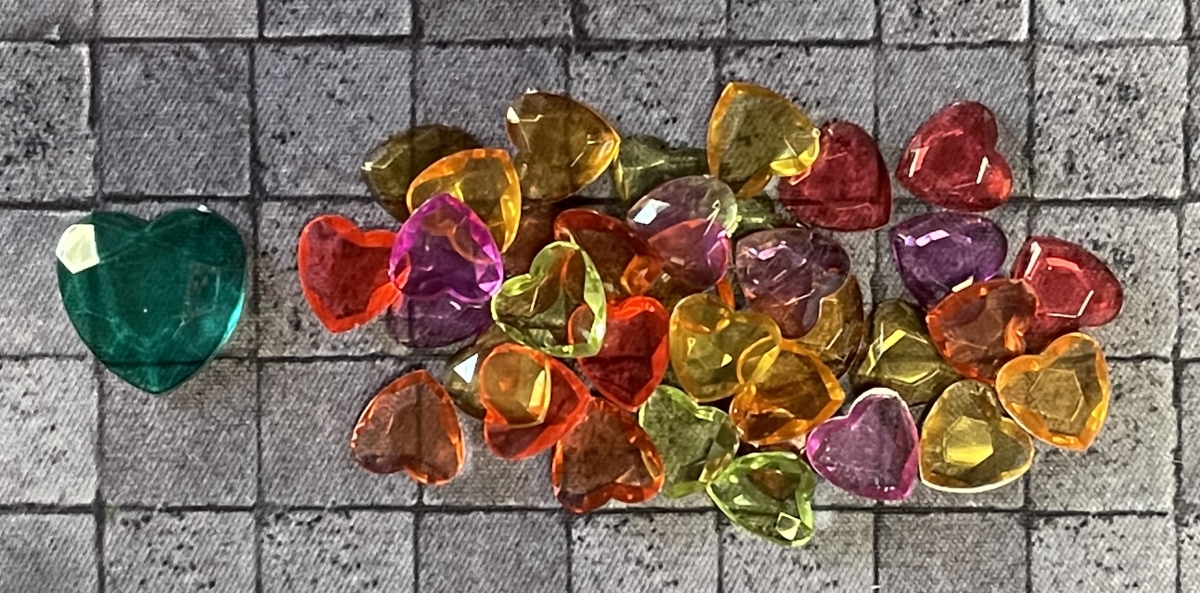
Should a Vagrant ever lose enough Humanity, they will take wounds. And if they take enough wounds, they become “Westbound.” Their abilities are then altered, and if that state is not reversed by the end of a scenario, could result in the permanent loss of a skill card. The flip side of the Vagrant card is their Westbound state.

Looking at the terrific illustrations on the Westbound side of their cards, it’s a shame that there aren’t matching Vagrant standees to go with them.
There is a cloth bag, called the Bindle, included with the game which will hold the Rummage tokens. Each token provides a specific benefit for the players, but are also used to randomly determine the course of action a Haint will take on its turn.
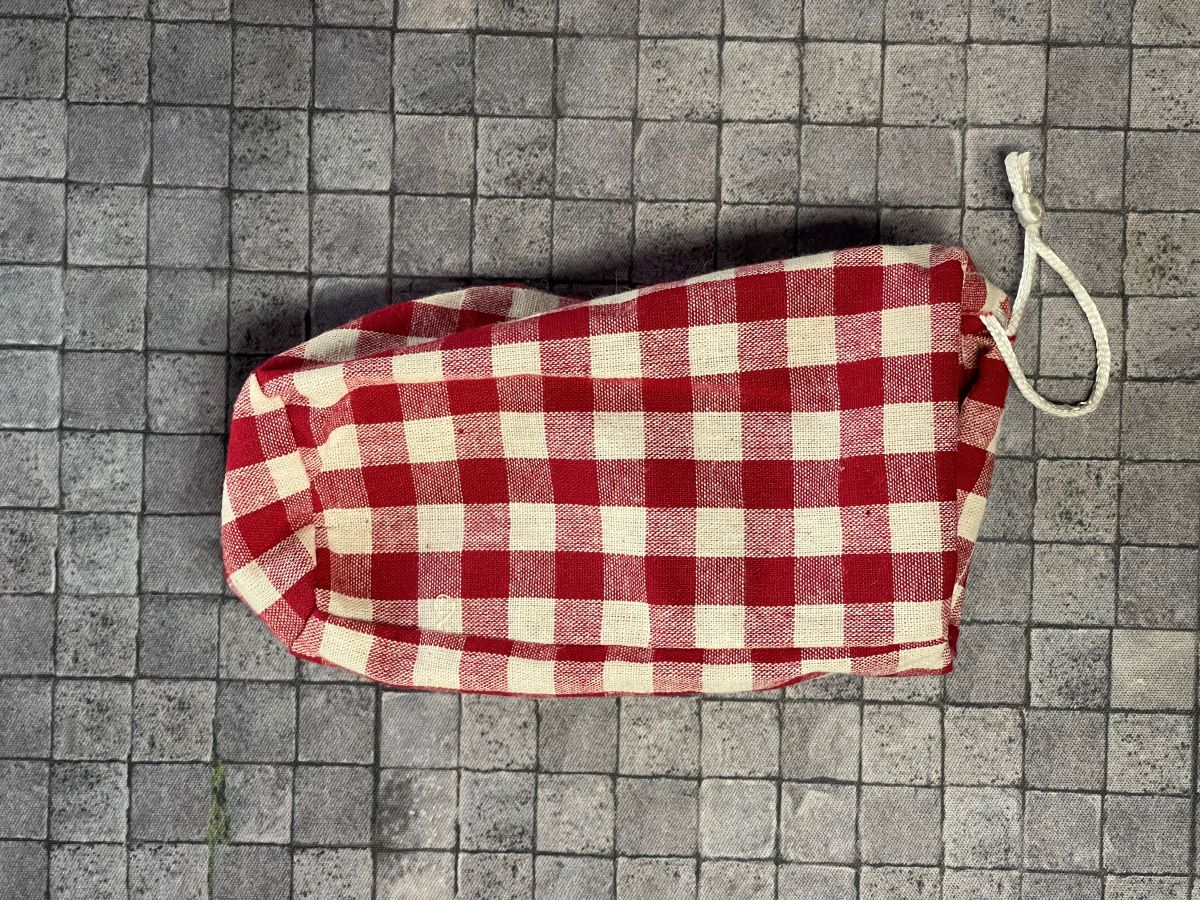
In addition to a rulebook, there is a separate scenario book, which provides players with all the information they need to set up and run each of the scenarios.

Each scenario includes a unique set of Rituals, which are placed on the Train Board during setup. These function somewhat like sidequests, which can aid the Vagrants during the scenario and will often reward coins that can be used during the Camp Phase at the end of a scenario. The cards are double-sided, with the reward for completing the Ritual on the other side. However, you aren’t supposed to look at that side until you’ve actually fulfilled the requirements of the Ritual.
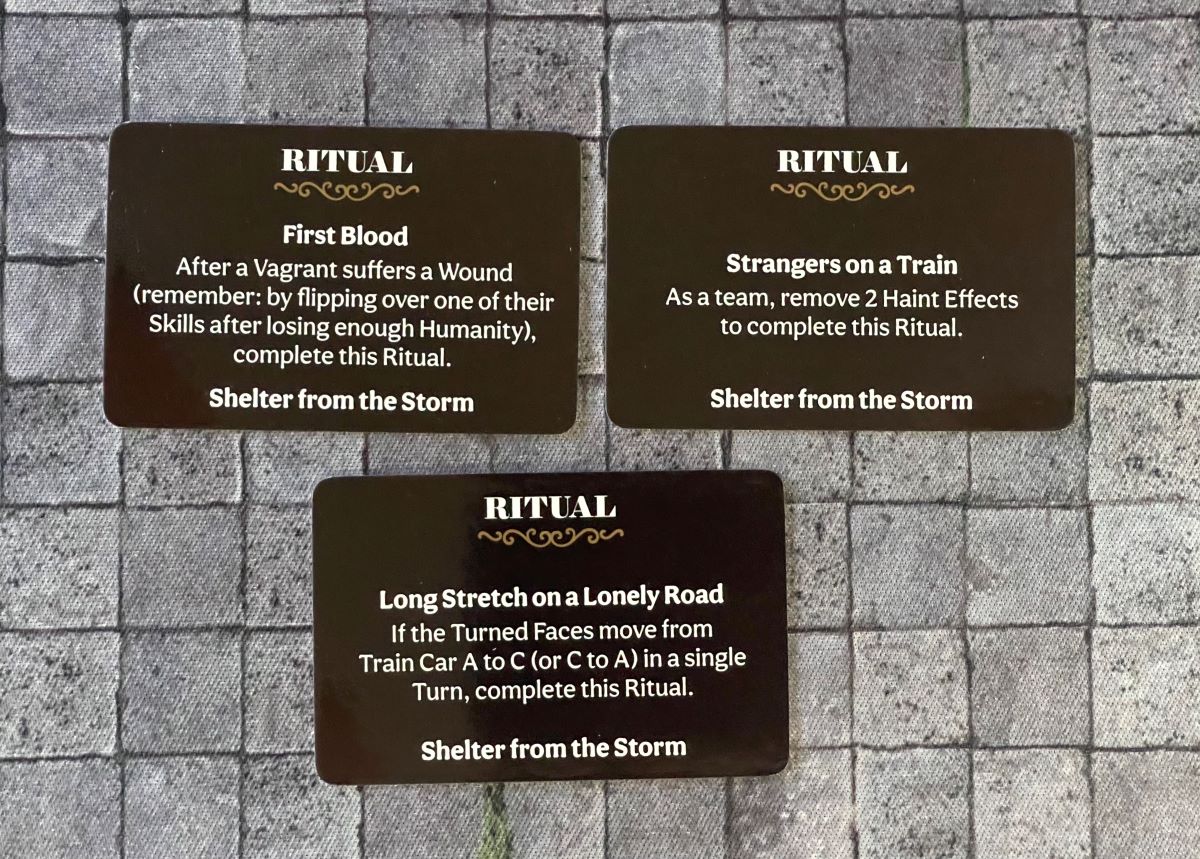
How to Play Vagrantsong
You can download a copy of the rulebook here.
The Goal
The goal of the game is to work together to restore the Humanity of the various Haints you will encounter, as you work your way sequentially through multiple scenarios and uncover the story of the haunted train.
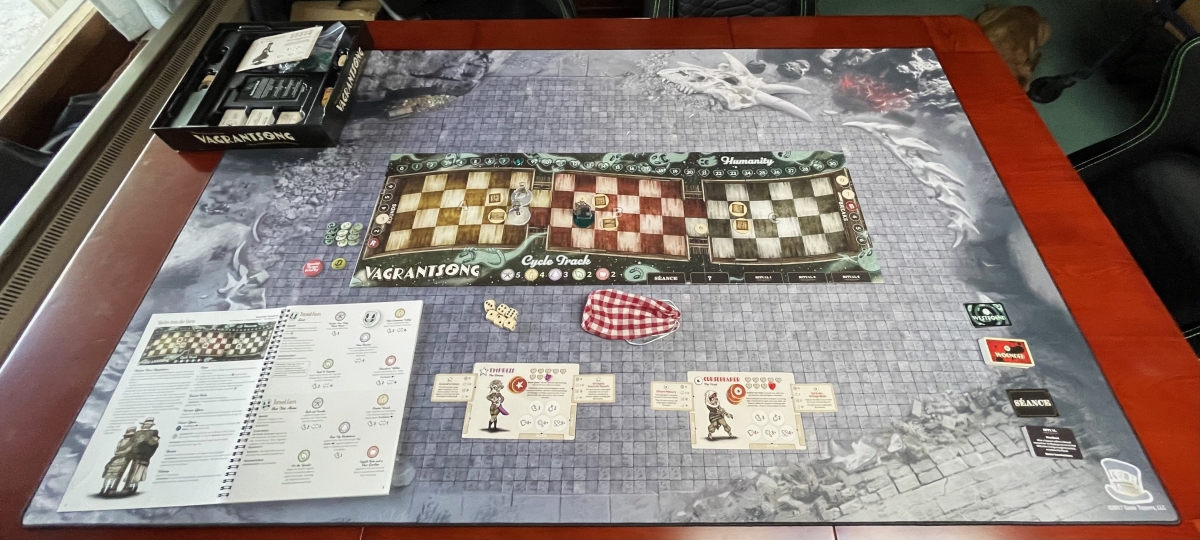
Setup
For the basic setup of the game, place the Train Board in the center of the table.
Each player will choose a Vagrant, and take their 3 coins, standee, and any starting skills or junk indicated in the rulebook. If this is a later scenario, then they will start with the skills and junk that the Vagrant had at the end of the previous scenario.
Place the Skill and Junk cards onto the edges of the player card at the indicated locations. Place the matching Humanity token on their maximum Humanity.

The rest of the setup is unique to each scenario, and you will follow the steps laid out in the scenario book.
Gameplay
A session of Vagrantsong is played in 2 Phases: The Scenario Phase, and the Camp Phase. The Scenario phase is the bulk of the game. In it, you will play through a series of consecutive rounds. After each Vagrant takes their turn, there is a Haint turn.
Vagrant Turn
On a Vagrant’s turn, they will have their 3 coins to spend on General Actions or Skills. You may perform as many actions as you have coins to spend.
Most actions will have you rolling Bones (ie, 6-sided dice). You will succeed on a roll if it meets or exceed the threshold shown on the action or skill. Additionally, whenever you roll “Booming Boxcars,” ie, a “6” on a die, you may immediately roll another Bone for that action.
General Actions
- Move – Vagrants may move orthogonally a number of spaces equal to their movement value. Vagrants may not move through obstacles, and cannot end in a space occupied by a Haint or another Vagrant but can move through them. For each coin you spend on movement, you will get another full move.
- Rummage – Draw 1 Rummage Token from the Bindle for each coin placed on the action. No matter how many tokens are drawn, the player only keeps one, returning the others to the bag. Each Vagrant has a maximum number of Rummage tokens they may hold at any one time, as shown on their cards. When Rummage tokens are spent, they are added to the Cycle Track on the bottom of the Train Board.

- Investigate – If a Vagrant is in the same space as an Event token, they can attempt to investigate it. The player turns to the Events page for the scenario (found in the scenario book) and reads aloud the first portion of the Event. They then roll a number of Bones equal to the number of coins they spent on that action. Compare the results of your roll to the success or failure as indicated for the event, and read and apply the results. Note- some events in scenarios will be placed on the various tracks on the Train Board during setup. These will trigger automatically when a marker reaches the token.
- Patch Up – Attempt to regain lost Humanity. Roll a number of Bones equal to the number of coins placed on the action. For each success, restore 1 Humanity.
- Bust – If the Vagrant is adjacent to a Haint, they may attempt this action. Roll a number of Bones equal to the number of coins placed on the action. For each success, the Haint regains 1 Humanity.
Skills
Skills are special actions unique to each Vagrant. Some Skills you will start with, and others are ones that you will gain thanks to events, or will purchase during the Camp phase.
Each skill has the following running down one side of the card:
- Target
- Range
- How many Bones to roll
- Value needed to succeed
Additionally, the text will tell you the effects of the skill.

Humanity, Wounds, and Westbound
If a Vagrant loses Humanity, they move their Humanity token down on the track on their card. If the token ever would go below 1, they suffer a wound, and then the Humanity token is placed back at the maximum value, ignoring any additional Humanity loss that may have been incurred on that turn.
When a Vagrant takes a wound, they either flip over one of their skill cards, or their junk card. If it is a skill card, they can no longer use that skill until the wound is healed. If it is a junk card, then that junk is Broken, and can no longer be used.

If all of a Vagrant’s skills and junk are flipped over, then that Vagrant becomes Westbound. The following occurs:
- Discard any Haint Effect tokens, flip the Vagrant card to the Westbound side, and set Humanity at 1. No further Humanity can be lost while it is at 1.
- Find your Vagrant’s Westbound Action card and place it on top of one of your Skill cards. A Westbound Vagrant may only perform General Actions, and their Westbound Action.
If a Vagrant is still Westbound at the end of a scenario, then at the start of the Camp Phase, they must permanently discard the Skill that they placed their Westbound Action card on.
When a Westbound Vagrant regains their maximum Humanity, flip over any one of their Wounded Skills, then flip their Vagrant card back to its normal side, setting Humanity to maximum.
Haint Humanity and Breaking a Haint
The Humanity for a Haint is established by each scenario, and marked with both a Threshold Token and a Humanity Token on the Humanity Track on the Train Board. The Threshold token indicates how much Humanity a Haint must gain before it Breaks.
When the Humanity Token reaches the Threshold, the Haint Breaks. Lower the Break value on the Haint’s Break Track by 1, and place their Humanity token back to 0. The next turn a Haint would take immediately ends without any actions performed, and all Vagrants in play gain 1 Humanity.
If the Break Track is at 1, and the Haint would break again, then the Haint is no longer trapped by the train and are saved. In the majority of the scenarios, this is also the victory condition.
Haint Turn
Every time a Vagrant finishes their turn, the Haint gets a turn. The Haint’s turn is performed in the following order:
- Determine the Haint action – The Vagrant who took the most recent turn draws a Rummage Token from the Bindle. Refer to the scenario to see what action the Haint will take. This is also determined by the mood of the Haint, which will change during the course of the game when certain conditions are met.
- Determine the Target Priority – there is a chart in the rulebook (and on the included reference cards) that shows which Vagrant the Haint will target.
- Move the Haint – The Haint will move up to its move value to reach its target. A Haint will always move so that it can Haunt as many Vagrants as it can, moving through them and giving them the particular Haunted Effect that’s specific to the current scenario.
- Resolve the Action – if the Haint action listed can’t be performed, then it is ignored.
- Add the Rummage Token to the Cycle Track – If adding that token causes its stack to equal or exceed its listed value, then the specific Cycle Effect for the Haint’s current mood in the scenario takes place at the end of the current player’s turn. After the Cycle Effect is resolved, all Rummage Tokens on the Cycle Track are added back to the Bindle.
Winning and Losing Scenarios
Each scenario has a victory condition, which most often involves saving the Haint. If the players meet the victory condition, then they have won the scenario.
If all players are Westbound during a scenario, they are defeated. Some scenarios will also have additional defeat conditions listed in their special rules.
Once players are either victorious or defeated, they move on to the Camp Phase.
The Camp Phase
The Camp Phase is broken into 2 parts: Tear Down and Build Up. First, at the very start of the Camp Phase, players will read a Moment from the back of the rulebook, based upon whether they won or lost the scenario.
During Tear Down, Vagrants flip over any cards from Westbound to normal side, and restore all Humanity to maximum. Any Haint Effects are removed, but skill cards remain wounded and junk broken.
During Build Up, Vagrants will collectively decide how to spend a pool of both their own individual coins as well as any coins earned from completing Rituals. These coins can be spent on:
- Acquiring New Skills – each scenario offers 2 common Skills to purchase, which can go to any vagrant. You are not allowed to look at the skill card until it is purchased, but the scenario hints at what it might do.
- Healing a Wound or Fixing Broken Junk – wounds and junk may be healed at the cost of 1 coin each.
- Rummage – You may take the Rummage General Action for the cost of 1 coin.
- Acquire Junk – At the start of the Camp Phase, shuffle the Junk Deck and reveal the top card. This is the only card that may be purchased during the Camp Phase, at a cost of 3 coins.
- Draw Different Junk – If no one likes the card revealed at the start of the phase, they can spend 1 coin to draw a new Junk Card.
- Perform a Seance – For 1 coin per vagrant in play, gain the Seance Card. This card will provide bonuses for the next scenario, which you will discover when you play the next scenario.
- Bank Coins – If you don’t spend some of your coins during the Camp Phase, you may Bank them. You mark off coins on the Mile Posts page of the rulebook, and once a certain number are banked, Vagrants will gain access to special Moments in the game that may have longterm impact on their game.
At the end of spending your coins, you can then choose to put the game away and save your progress, if everyone is done for the session. All Vagrants do get their three personal coins returned to them.
If you continue, you have the option of changing out skills and junk, or even changing to an entirely new Vagrant. I won’t go into the specific details here, but you can always read them in the rulebook.
Finally, you will “Witness the In-Between.” Players take the In-Between Card for the scenario, read it aloud, and then collectively choose between the options offered on the card. After selecting their option, players flip over the card. They then read and apply the results of their choice.
Players then proceed to the next scenario.
End of Game
The campaign in Vagrantsong runs through 23 scenarios. Once you have completed all the scenarios, you will have completed the campaign and its story.
Vagrantsong is GeekDad Approved!
Why You Should Play Vagrantsong
Campaign-style games are always difficult to discuss, because you don’t want to inadvertently spoil any of the story for potential players. And while this is not as story-heavy of a campaign game as, say, Tainted Grail or Oathsworn, the writing is quite good and really captures a Depression-era feeling. There are lots of nice moments throughout, with interesting outcomes both when you succeed and fail at tests.
And while there is a narrative that you will slowly uncover as you play through the scenarios, this is, first and foremost, a boss-battling game. Each of the scenarios has its own feel, with different actions and Haunt Effects for each of the Haints. I especially like that the Haints have two different moods, each with their own set of behaviors. This provides a nice change of rhythm to the scenarios, and really helps to make each boss fight feel dynamic.
With a limited number of coins for Vagrant actions, the gameplay moves along at a nice pace. Turns tend to be quick, and having the Haint go after each Vagrant’s turn keeps the pressure up and will often result in players needing to change up their tactics based on what actions the Haint takes on its turn.
Drawing tokens from the Bindle is a great way to manage the A.I. for the Haint. All you have to do is match the symbol to the one in the scenario you’re playing (and the Haint’s current mood) and you know what action the Haint will take. This simple system allows all sorts of potential different actions for the Haints. Each Haint will have up to 10 different actions they can take during a scenario.

Losing a scenario will provide players with some setbacks. Each Vagrant that ends the game Westbound will end up losing one of their Skills, and will need to spend coins in the Camp Phase to acquire more skills and also repair their broken junk and heal their wounds. But none of these setbacks is crushing, and importantly you never have to repeat a scenario to progress in the game. Win or loss, you can head on to the next boss battle and move the story forward.
It’s a good idea for each Vagrant to max out their skills as soon as they can. You begin the game with 2 Skill Cards, which means that you can fully lose your Humanity twice before you become Westbound. Each Skill Card (as well as each Junk Card) provide you with another possible wound. So if you were maxed out with Skills and Junk, you could take 5 wounds before you became Westbound…or if you’re playing the Wayfarer, you could take 6!
There’s some nice variety in the playstyles of the different Vagrants, which of course can also be tweaked by adding different Skills or Junk. Gameplay overall is easy to learn, but you still get good strategic choices each turn. I find it’s helpful to be able to choose the order that the Vagrants will go in. You will end up in situations, much like any cooperative game, where you’ll benefit by the players going in a different order each round.
Vagrantsong marries engaging gameplay with great writing and fantastic components. The choice to make the bag that you draw Rummage tokens from look like a traditional Bindle that hobos would tie to a stick to carry their possessions is just one example of how well the components reinforce the theme. The designers absolutely made the right decision by going with the acrylic standees, and the lovely artwork ties the whole game together into one very pleasing package. If you’re looking for a fun and very unique boss-battling, campaign-style game, then you’ll definitely want to try out Vagrantsong.
For more information, visit the Vagrantsong webpage!
Click here to see all our tabletop game reviews.
![]() To subscribe to GeekDad’s tabletop gaming coverage, please copy this link and add it to your RSS reader.
To subscribe to GeekDad’s tabletop gaming coverage, please copy this link and add it to your RSS reader.
Disclosure: GeekDad received a copy of this game for review purposes. As an Amazon affiliate, I may earn a small commission on qualified purchases.






